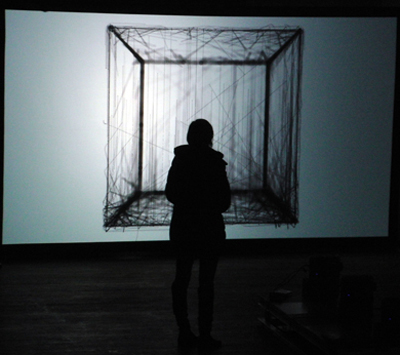In When Do I See Photons? Oswald Wiener, cybernetician, author, and inspiration for the inaugural exhibition at the Goethe-Institut’s new locale, poses this very question. Photons, the smallest particles of light, stimulate our retinas. So what does it mean to ‘see’? Five artists, all students at Transmedialen Raum de la Kunsthochscule für Medien Köln, a prominent German media school, seek to answer this question through a mix of software and nature.
Four of the exhibit’s five works are short films projected onto a screen, and are visible from both inside and outside of the building through the institute’s floor-to-ceiling windows. These films looped one after the other, interrupted only by white-on-black titles and credits. Jan Goldfuss’ EntroPI, by far the most intriguing and unusual piece, used mathematical procedures and algorithms to create a complex black-on-white animation. This piece felt inherently organic, playing with the mind, making the viewer question what it is the eye perceives. Is it airborne bacteria, smoke, or dust? Lines, waves, and geometric formations emerge subtly from the multi-dimensional canvas created within, and just as quickly melt away from perception. While entirely computer-generated (the artist goes so far as to leave exposed animation framework and holes to demonstrate this), EntroPI manages to be universal, and naturally stunning.
In Cellular Performance, Verena Friedrich documents the manipulation of human and animal cells in black and X-ray white. These cells shift to form words and letters that come in and out of focus with the motions of the living organisms that constitute them. It’s an interesting concept to wrap one’s mind around; is this a statement on the impermanence of language, the ever-changing nature of human invention, or the idea that technology takes on a life of its own? The answer is unclear, but Friedrich’s cells are engaging to observe and make one feel acutely mortal and self-aware.
Though interesting and emotionally engaging, the three remaining works are less visually arresting. Suija Kim’s [S] offers an up-close, greyscaled view of natural objects and phenomena. Stones, waves, and exploding geysers are filmed with dizzying camera angles and points of view that play with the ability to comprehend what it is that’s being shown on screen. Hörner/Antlfinger’s Two Homes juxtaposes footage of a farm and chicken coop with edited YouTube clips of a small parrot performing impressive tricks and caressing his owner’s hand. The fifth artist, Vera Drebusch, was present to engage visitors in her work Beamer Walks—essentially a tour of Montreal’s Quartier des Spectacles by the light of an electric torch. This was then captured on camera to become, in turn, one of the films being shown.
As my mom pulled up beside the Goethe-Institut to give me a lift home, she passed the films projected in one of the windows, as well as the glass room in which a mini-rave complete with colourful strobe lights and an excellent DJ imported from Germany for the occasion was taking place, and said bemusedly, “Are you sure this is an art exhibition?” Pass by the Goethe-Institut to see for yourself, but the five artists on display, though often esoterically, manage to raise not only the question of When do I See Photons and what it means to see, but the most fundamental question of all: What is art?
When Do I See Photons? runs through Dec. 31 at the Goethe-Institut, 1626 Saint Laurent. Admission is free.









